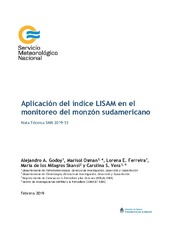Aplicación del índice LISAM en el monitoreo del monzón sudamericano
Autores

Resumen
En este trabajo se muestra la implementación del índice LISAM (Large-Scale Index for the South American
Monsoon) con el fin de incluir una nueva herramienta para el monitoreo del Monzón Sudamericano y su
impacto en las regiones subtropicales. Este índice está basado en la componente principal obtenida a partir
de un análisis de Funciones Ortogonales Empíricas (EOF) realizado en forma “combinada” a partir de las
anomalías de precipitación, humedad específica, temperatura del aire, viento zonal y meridional en el nivel
de 850 hPa, calculado en un dominio en el norte de Sudamérica.
La implementación del índice reprodujo en forma satisfactoria los resultados de otras investigaciones. Por
otro lado, se analizó la sensibilidad del índice a diferentes dominios extendidos hacia regiones
extratropicales, observándose pocos cambios en su estructura. Además, se encontró que al extender el
dominio donde se calcula el índice, las fechas de inicio y fin del monzón se modifican. Por último, se utilizó
el índice LISAM para monitorear el monzón durante el año 2017. Los resultados muestran la enorme utilidad
de esta herramienta para detectar el rompimiento y la intensificación del sistema monzónico como así
también el inicio y finalización del mismo.
We describe the implementation of the LISAM index (Large‐scale index for South America Monsoon) to be
added as a new tool for monitoring the South American Monsoon and its impact on subtropical regions. This
index is based on the first “combined” component of the Empirical Orthogonal Functions (EOFs) that is
performed from the anomalies of precipitation, specific humidity, air temperature, zonal wind and meridional
wind at 850 hPa, calculated in a domain in northern South America.
The implementation of the index reproduced satisfactorily results from other investigations. It is also shown
that the index displays little sensitivity to the choice of different domains when extended towards extratropical
regions, although the start and end dates of the monsoon do change. In addition, we observed few changes
in its structure. Finally, we use the LISAM index to monitor the monsoon during the year 2017. Results show
the great benefit of having this tool to detect the breaking and intensification of the monsoon system as well
as the start and end of it.
Cita
Colecciones
- Notas técnicas [205]
Fecha
2019-02Metadatos
Mostrar el registro completo del ítemUtilice este identificador (URI) para citar o enlazar este item
http://hdl.handle.net/20.500.12160/962El ítem tiene asociados los siguientes ficheros de licencia: